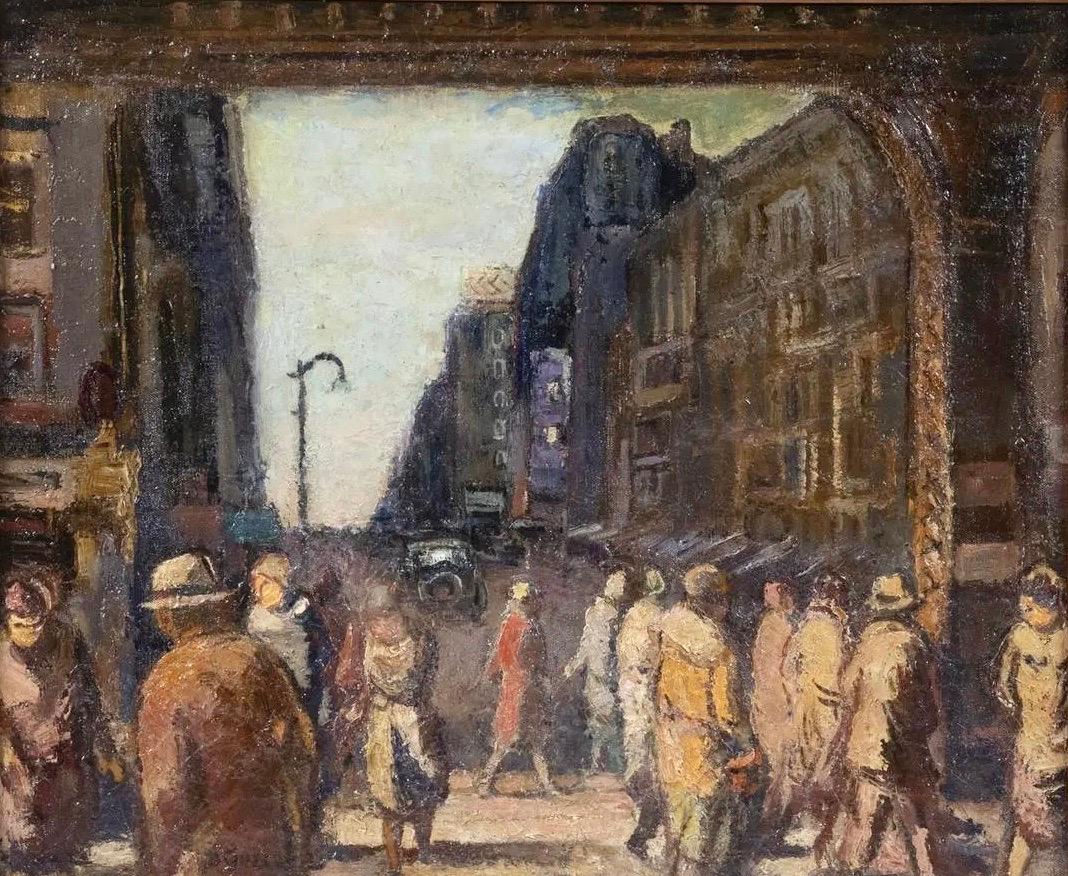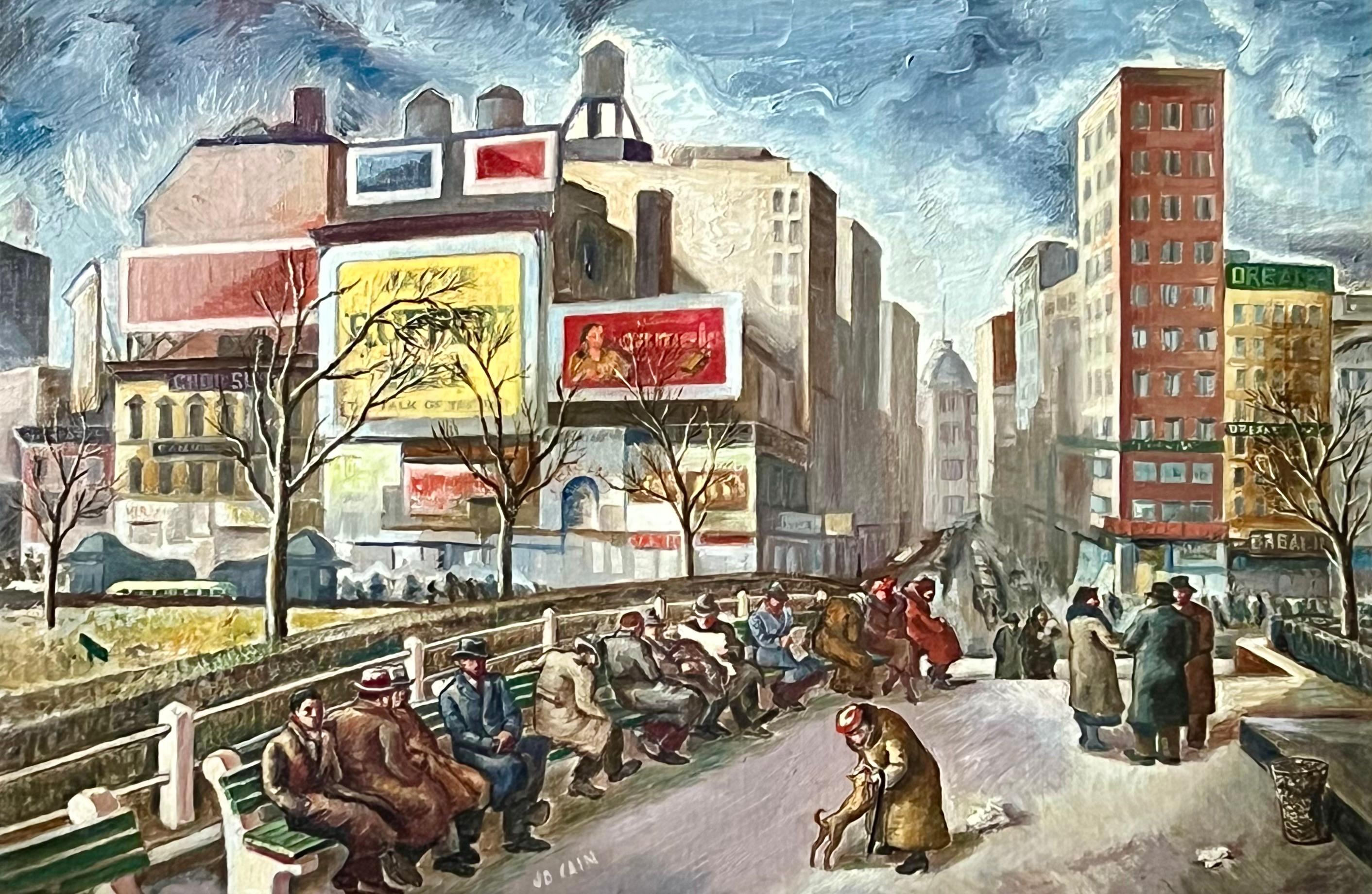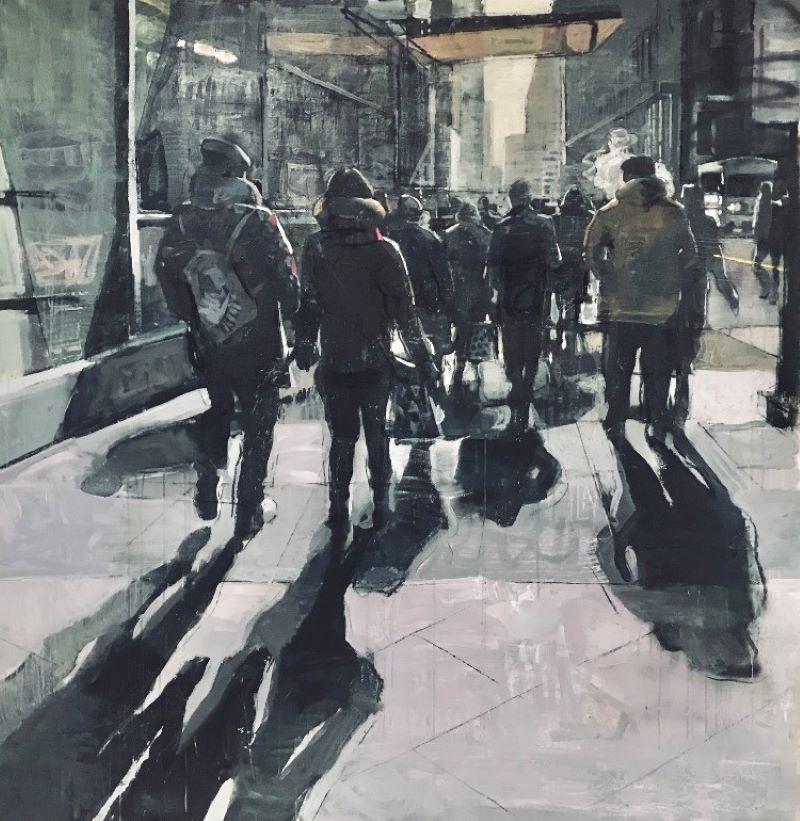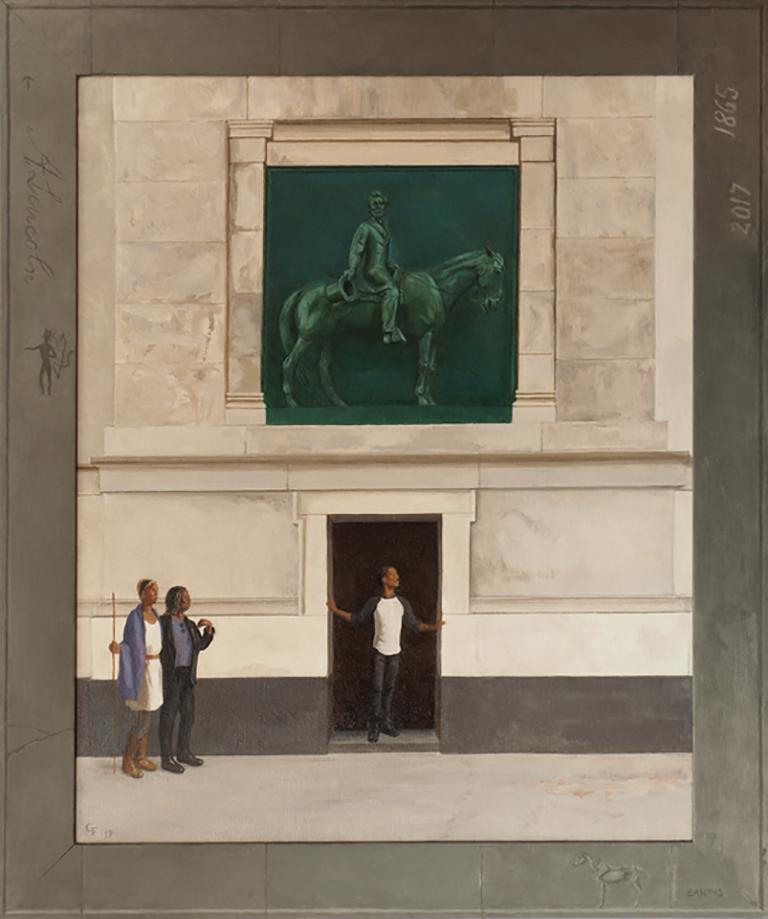Items Similar to At the Spring
Want more images or videos?
Request additional images or videos from the seller
1 of 8
Joshua ShawAt the Spring1849
1849
About the Item
Joshua Shaw was a farmer’s son, born in Billingborough, Lincolnshire, and orphaned at the age of seven. After a boyhood of privation, he tried a number of occupations, until he finally apprenticed to a sign painter and found his métier. Shaw went to Manchester to study art, and by 1802 was in Bath, painting landscapes. In that year he began to exhibit his work at the Royal Academy in London. Essentially self-taught, Shaw achieved an impressive level of competence and versatility, producing portraits, floral compositions, still lifes, landscapes, and, cattle pieces. Shaw continued to send works for exhibition at the Royal Academy, the British Institution, and the Suffolk Street Gallery, all in London, until 1841. (Although Shaw is regularly mentioned and frequently illustrated in a host of general books on American art history, as well as included in numerous historical survey exhibitions, the only monographic study of this artist is Miriam Carroll Woods, “Joshua Shaw [1776–1860]: A Study of the Artist and his Paintings” [M.A. thesis, University of California at Los Angeles, 1971]. Apart from short biographical sketches in various dictionaries and museum collection catalogues, the two most interesting references, both contemporary, are John Sartain’s personal recollections in The Reminiscences of a Very Old Man, 1808–1897 [1899; reprint 1969] and an article in Scientific American from August 7, 1869, “Joshua Shaw, Artist and Inventor.” The article quotes extensively from an autobiographical document in the possession of Shaw’s grandson that Shaw prepared for William Dunlap when Dunlap was collecting data for his History of the Rise and Progress of the Arts of Design in the United States [1834].)
Shaw was determined to succeed, and London defined success. By 1813, Shaw had moved from Bath, where he enjoyed considerable local esteem to the capital city. In that year he showed his ambitious The Deluge, towards Its Close at the British Institution, where it attracted favorable critical attention (the painting is now at The Metropolitan Museum of Art, New York, see John Caldwell and Oswaldo Rodriguez Roque, American Paintings in The Metropolitan Museum of Art, Volume I: A Catalogue of Works by Artists Born by 1815 [1994], pp. 273–77, p. 277 illus.). At some point Shaw became acquainted with the famous American expatriate and President of the Royal Academy, Benjamin West. West made Shaw the guardian of his epic canvas, Christ Healing the Sick in the Temple, which he had painted for the Pennsylvania Hospital in Philadelphia. Shaw and the painting sailed on the Electra, arriving in Philadelphia in 1817, where Shaw supervised the unpacking and hanging of West’s munificent gift. Shaw, who was throughout his life both restless and prone to fits of irascibility, decided to leave England behind. He remained in Philadelphia, where his wife joined him in the following year.
Shaw’s first projects in his new country involved traveling and sketching scenic locales for an illustrated travelogue. Picturesque Views of American Scenery was published in Philadelphia in 1819 with engravings by his fellow English immigrant, John Hill (1770–1850). A second illustrated travel book, United States Directory for the Use of Travelers followed in 1822. Shaw was an activist and an organizer and a principal player in a series of art initiatives in Philadelphia. In 1835, he was among the founders of the Artist’s Fund Society, a breakaway group from the Pennsylvania Academy of Art. Two years later, after quarrelling with the Society’s President, John Neagle, he led a dissident group in establishing the Artists’ and Amateurs’ Association. He left that also after a brief time. Shaw’s differences with the Pennsylvania Academy did not keep him from being among its most active exhibitors. Beginning in 1818, Shaw showed over 75 pictures at the Academy, ending two years after his death in 1862.
Shaw was also an early exhibitor at James Herring’s Apollo Gallery in New York City, the forerunner to the American Art-Union. His correspondence with Herring (who had also been, at one time, a Philadelphia artist) offered Shaw an opportunity to complain about the vicissitudes of the artist’s life including the injuries incurred from destructive critics and the harms inflicted by enemy colleagues. Indeed, a deal of Shaw’s energy was taken up in struggle, and not just in the art world. Like many artists before and since, Shaw was an inventor as well as a fine artist. In his case, he invented an important copper percussion cap for heavy artillery, as well as the glazier’s revolving diamond for cutting curves in glass. According to his own account (as published in the 1869 Scientific American), Shaw invented the percussion cap in 1814 in England, but did nothing with the invention until he came to America. When he attempted to patent his invention, his application was denied on the grounds that he had not met the criteria of having been a resident of the United States for the previous two years. Shaw struggled mightily with the patent system and is credited with later reforms to the law. He was able to patent his percussion cap in 1822, as well as additional firearm improvements in 1828. He was eventually awarded $25,000 by the United States Congress for his invention, of which he received $17,000. This money, although agreed upon, was also not easily extracted from the Federal government and Shaw made numerous trips to Washington, D.C., to advocate for himself. According to Sartain, Shaw received, for his inventions, “a present of a purse of money” from the Czar of Russia. In 1833, Shaw traveled back to England, in an attempt to claim disputed patent rights there. Around this time, he also exhibited paintings at the Royal Society of British Artists.
Despite all of this, Shaw was primarily an artist. He was an Honorary Member of the National Academy of Design, New York, from 1828 until his death in 1860 and exhibited there regularly from 1828 through 1852. (He was “Honorary” because he did not live in New York and therefore was not eligible for regular academician status.) His participation with the Art-Union lasted through 1848 (the Art-Union closed down in 1851). It is clear from the titles of works that Shaw exhibited at these venues that he continued throughout his career to paint English and European subjects as well as American. Shaw remained in Philadelphia until about 1843, when he moved to nearby Bordentown, New Jersey. Bordentown had become something of an artist’s colony due to the presence of Joseph Bonaparte, Napoleon’s brother, and former King of Spain and Sicily, who in 1817 bought the estate, Point Breeze, and built a mansion that included a gallery for his substantial art collection. Although Joseph returned to Europe in 1839 and died there in 1844, his family kept the estate until 1847. Shaw remained in Bordentown for the rest of his life, acquiring a house of his own in 1847. Shaw continued his activity as an artist until 1853, when a stroke put an end to his painting career.
At the Spring is a genre scene that recalls Shaw’s boyhood in rural England. It also very much reflects the European influences on Shaw that William H. Gerdts outlines in his brief but seminal discussion of the artist in Painting and Sculpture in New Jersey (1964, pp. 57–60). Shaw was a mature artist when he arrived in the United States. His work, according to Gerdts, echoes concerns and themes expressed in the rococo style of the French artist, François Boucher (1703–1770), as well as the canvases of Phillippe de Loutherbourg (1740–1812) who emigrated from the continent to England, the Dutch artist Nicholas Berchem (1620–1683), and English genre artists George Morland (1763–1804) and Julius Caesar Ibbetson (1759–1817), all of whose work Shaw knew from his time in England. Caldwell and Roque (American Paintings in The Metropolitan Museum) also find echoes in Shaw of two mainstays of eighteenth-century English art, Richard Wilson (1714–1782) and Thomas Gainsborough (1714–1782). All of this is consistent with the methodology of an auto- didact whose chief means of education was to observe as closely as he could the techniques and subjects of the leading men of his day. The consequence for this with regard to Shaw’s oeuvre, is that in America, Shaw was very much sui generis, an artist whose style was, in origin, and remained throughout his career, essentially English.
- Creator:Joshua Shaw (1776 - 1860, British)
- Creation Year:1849
- Dimensions:Height: 10.5 in (26.67 cm)Width: 14 in (35.56 cm)
- Medium:
- Movement & Style:
- Period:
- Framing:Framing Options Available
- Condition:
- Gallery Location:New York, NY
- Reference Number:
About the Seller
5.0
Recognized Seller
These prestigious sellers are industry leaders and represent the highest echelon for item quality and design.
Established in 1952
1stDibs seller since 2010
32 sales on 1stDibs
Typical response time: 6 hours
Associations
Art Dealers Association of America
- ShippingRetrieving quote...Ships From: New York, NY
- Return PolicyThis item cannot be returned.
More From This SellerView All
- The GatewayBy Eleanor Parke CustisLocated in New York, NYSigned (lower right): ELEANOR PARKE CUSTISCategory
20th Century American Realist Landscape Paintings
MaterialsPaper, Gouache
- Peek-a-BooBy Seymour Joseph GuyLocated in New York, NYIn the latter half of the nineteenth century and into the first decade of the twentieth, New York City art aficionados could count on finding recent work of Seymour Joseph Guy hanging on the walls of the city’s major galleries. Primarily a genre artist, but also a portraitist, between 1859 and 1908 Guy showed more than seventy works at the National Academy of Design. From 1871 to 1903 he contributed over seventy times to exhibitions at the Century Club. From 1864 to 1887, he sent about forty pictures to the Brooklyn Art Association. A good number of these works were already privately owned; they served as advertisements for other pictures that were available for sale. Some pictures were shown multiple times in the same or different venues. Guy was as easy to find as his canvases were omnipresent. Though he lived at first in Brooklyn with his family and then in New Jersey, from 1863 to his death in 1910 he maintained a studio at the Artist’s Studio Building at 55 West 10th Street, a location that was, for much of that period, the center of the New York City art world. Guy’s path to a successful career as an artist was by no means smooth or even likely. Born in Greenwich, England, he was orphaned at the age of nine. His early interest in art was discouraged by his legal guardian, who wanted a more settled trade for the young man. Only after the guardian also died was Guy free to pursue his intention of becoming an artist. The details of Guy’s early training in art are unclear. His first teacher is believed to have been Thomas Buttersworth...Category
19th Century American Realist Figurative Paintings
MaterialsCanvas, Oil
- Jardin des Tuileries, ParisBy Edmund QuincyLocated in New York, NYSigned (lower right): QuincyCategory
20th Century American Realist Figurative Paintings
MaterialsCanvas, Oil
- The RaceBy William John HennessyLocated in New York, NYWilliam John Hennessy was born in Ireland. He came to America in 1849 with his mother and brother a year after his father had fled their homeland after taking part in the unsuccessful Young Ireland Party uprising. The Hennessys settled in New York, and when young William came of age, he decided upon a career as an artist. At the age of fifteen, he enrolled at the National Academy of Design, where he learned to draw from the antique, and the following year he was granted admission to the Academy’s life-drawing class. Hennessy first exhibited at the National Academy in 1857, starting a continuous run of appearances in their annuals that lasted until 1870, when he expatriated himself to Europe. During his time in America, Hennessy was principally known as a genre painter and prolific illustrator for such publications as Harper’s Weekly and a number of books, including illustrated works of William Cullen Bryant...Category
19th Century American Realist Figurative Paintings
MaterialsCanvas, Oil
- Copley Square, BostonBy Thomas FransioliLocated in New York, NYThomas Fransioli’s cityscapes are crisp and tidy. Buildings stand in bold outline, trees are sharp, and saturated color permeates the scene. But Fransioli’s cities often lack one critical feature: people. His streets are largely deserted, save for the rare appearance of figure and the occasional black cat scurrying across pavement. Instead, humanity is implied. Magic Realism neatly characterizes Fransioli’s viewpoint. First applied to American art in the 1943 MoMA exhibition “American Realists and Magic Realists...Category
20th Century American Realist Landscape Paintings
MaterialsCanvas, Oil
- Chestnut Racehorse with a Jockey Up On a Training StrapBy Henry H. CrossLocated in New York, NYIt was Henry Cross's portraits of horses belonging to the prominent breeders and trainers of the second half of the nineteenth century that won the artist renown as an animal painter. Born and raised in upstate New York, Cross's proficiency in both drafting and caricature was revealed while he was still a student at the Binghamton Academy, New York. In 1852, when he was only fifteen years old, Cross joined a traveling circus that took him to Minneapolis, Minnesota, and to the first of many Indian encampments that he would draw upon for subject matter throughout his career. Biographers differ as to the year Cross left for Europe, however, he was in Paris from 1852 to 1853 or 1854, where he studied with Rosa Bonheur, a highly esteemed French painter of horses. Upon Cross's return to the United States he was commissioned to paint the studs of wealthy horsemen, including those of Commodore Cornelius Vanderbilt, Robert Bonner, the owner-publisher of The New York Ledger, and "Copper King" Marcus Daly, whose 18,000 acre stock farm was reputed to be the greatest and most valuable horse ranch in the world. Although Cross received the highest pay of any equine artist of his day (up to $35,000. for one order, according to The Horse Review of April 10, 1918, p. 328), he frequently joined traveling circuses and painted the locales where they visited. He also painted portraits of notable contemporaries, such as President Abraham Lincoln, ex-president Ulysses S. Grant, King Edward VII of England, W. F. "Buffalo Bill...Category
19th Century American Realist Animal Paintings
MaterialsCanvas, Oil
You May Also Like
- Rio Hondo, Cowboy Oil Painting on Canvas, Western ArtBy Dennis LyallLocated in Whitefish, MTRio Hondo by Dennis Lyall Oil on Canvas 16" x 24" 21" x 30" (framed) Dennis Lyall is an artist and illustrator with more than 40 years of experience in working with many of the bigg...Category
21st Century and Contemporary American Realist Landscape Paintings
MaterialsCanvas, Oil
- Columbus Avenue NYC c. 1920s/30s American Scene Ashcan WPA Modern 20th CenturyBy Bernard GussowLocated in New York, NYColumbus Avenue NYC c. 1920s/30s American Scene Ashcan WPA Modern 20th Century "Late Afternoon, Columbus Avenue, New York", impasto oil on canvas, signed lower left, signed verso (under relining, shown in photo), and titled verso on stretcher, in maple mitered cove frame, 23 1/4" x 27 1/4", SS: 19 1/4" x 23 1/4", Relined. BIO Russian-born Gussow trained at the Art Students League and the National Academy of Design. He also studied under Bonnat at the Ecole des Beaux-Arts in Paris. His first claim to fame was exhibiting two works at the Armory Show in 1913. Gussow exhibited at the Society of Independent Artists between 1917 and 1934 and at Salons of America in the 1930s. The Whitney Museum of American Art, for example, has his Subway Stairs. The Barnes Foundation...Category
1920s American Realist Figurative Paintings
MaterialsCanvas, Oil
- UNION SQUARE Depression Era Oil Painting WPA Realism American Scene Realism NYCBy Jo CainLocated in New York, NYUNION SQUARE Depression Era Oil Painting WPA Realism American Scene Realism NYC Jo Cain (1904 – 2003) "Union Square," 24 x 36 inches. Oil on canvas, c.1940s, ...Category
1940s American Realist Figurative Paintings
MaterialsCanvas, Oil
- "Double Shadow", Oil PaintingBy Kevin WeckbachLocated in Denver, COKevin Weckbach's (US based) "Double Shadow" is an original, hand made oil painting that depicts a busy city avenue filled with throngs of bundled walkers casting long shadows on the ...Category
2010s American Realist Landscape Paintings
MaterialsOil, Canvas
- America 2017, New York, urban architecture, subtle colorBy Gregory FruxLocated in Brooklyn, NYOil on canvas Dr. Rowland S. Russell PhD. writes about his experience directly witnessing Greg's practice as a “plein air” artist: Whether he’s portraying quiet scenes from Brooklyn...Category
2010s American Realist Landscape Paintings
MaterialsCanvas, Oil
- "Misty City", Oil PaintingBy Christopher Clark 1Located in Denver, COChristopher Clark's (US based) "Misty City" is an original, handmade oil painting that depicts orange and green hued clouds arching over a water and city lights Bio/artist statement: Christopher has been an artist since early childhood, when he would watch Bob Ross on PBS and mimic the famed oil painter’s art with crayons. He considers himself a self-educated artist, with his studies ranging from personal training with contemporary masters, to classical academic art technique, with much inspiration from 19th Century art and the Impressionist Movement. Christopher lived in Italy for a time, immersing himself in Italian culture and art, which continues to influence his painting. His fan base has grown considerably since his return to the US, gaining the attention of Lucasfilm and Marvel Fine Art, which both signed him as an officially licensed artist in 2016. Other clients include George Lucas, Major League Baseball, Louisville Slugger...Category
2010s American Realist Landscape Paintings
MaterialsCanvas, Oil, Panel
Recently Viewed
View AllMore Ways To Browse
The Springs
Men At
The Origin Of The World
Antique Springs
Dior Around The World
The Shaw
Dior Spring Collection
1849 Painting
Rural England
American Art Painting Scenic
English American Landscapes
Oil Paintings California Spring
The Reform
Antique Painting Art Collectibles
He Shaw
Thomas Downing Paintings
Sicily Purse
This Is The Enemy





